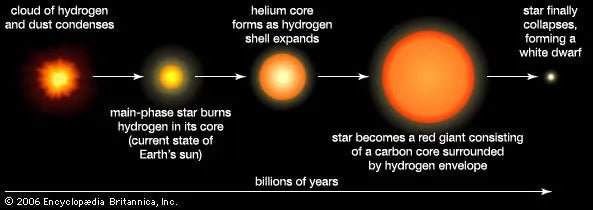From Birth to Death
The life of a star, including our own Sun, is a cosmic tale of transformation and energy. From its nascent phase in a giant molecular cloud to its inevitable demise, a star undergoes multiple stages that are driven by complex physical processes. The solar lifecycle may span billions of years, but its stages are sufficiently understood to piece together a captivating narrative.
Formation: The Stellar Nursery
Every star, including our Sun, begins its life in a stellar nursery—regions of space abundant with gas and dust, also known as giant molecular clouds. When external triggers like supernova explosions disturb these clouds, areas within them start collapsing under their own gravity. As the core of a collapsing region gets denser and hotter, a protostar is formed, which will eventually become a new star.
Main Sequence: The Prime of Life
After the protostar phase, the core temperature rises enough for nuclear fusion to begin. Hydrogen atoms combine to form helium, releasing an enormous amount of energy in the process. This energy counterbalances the gravitational pull trying to collapse the star, leading to a stable phase known as the "Main Sequence." Our Sun is currently in this phase, about 4.6 billion years into its approximately 10-billion-year Main Sequence life. In this phase, the Sun continuously fuses hydrogen into helium, powering the solar system and sustaining life on Earth.
Red Giant: The Midlife Crisis
As the star ages, the hydrogen in its core gets depleted, while helium accumulates. With insufficient hydrogen to counterbalance gravity, the core contracts, and the outer layers expand and cool down. The star evolves into a "Red Giant." In this phase, the core temperature is high enough for helium fusion to occur, generating carbon and other heavier elements. For our Sun, this phase will last a few hundred million years. It will expand so much that it will likely engulf the inner planets, including Earth.
Helium Flash and Planetary Nebula
For stars similar in size to our Sun, the core will eventually experience a "Helium Flash," a rapid and brief period of helium fusion. The outer layers of the star are expelled, forming a "Planetary Nebula." The nebula is a colorful shell of ionized gas and represents one of the most visually striking phases of stellar evolution.
White Dwarf: The Retirement Phase
What remains after the Planetary Nebula is a "White Dwarf," a dense, Earth-sized core of the star that no longer undergoes fusion. These celestial remnants shine only by emitting their residual heat. Over billions of years, white dwarfs will cool down and fade away, eventually becoming "Black Dwarfs," although the universe is not old enough for any black dwarf to exist yet.
Solar Demise: Beyond the White Dwarf
While our Sun lacks the mass to become a supernova or form a neutron star or black hole, its end will still be dramatic. The fate of a white dwarf is to become colder and less luminous over time, effectively disappearing from sight but remaining a cold, dark mass.
Cosmic Recycling: The Circle of Stellar Life
Interestingly, the death of stars like our Sun contributes to the birth of new stars. The elements produced during the lifetime of a star are dispersed into space, enriching the interstellar medium with heavier elements. These elements are crucial for the formation of planets and life, closing the loop on the solar lifecycle and ensuring the cosmic circle of life continues.
Understanding the solar lifecycle offers more than just a glimpse into the life of our Sun. It provides essential insights into cosmic evolution, the creation of elements, and even the conditions that make life possible. While stars may have finite lifespans, their impacts are eternal, echoing across time and space in a never-ending cosmic dance.



Share:
The Sun's Latest Mysteries Unveiled
Annular vs. Total Eclipses